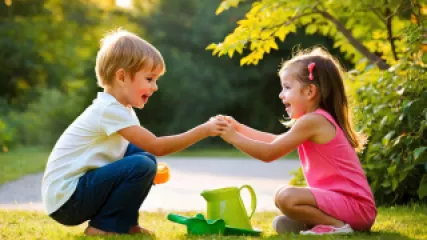5 Proven Strategies for Sibling Harmony
5 Proven Strategies for Sibling Harmony: An Expert Interview with Everly Cummings
Sibling relationships can be complex, filled with moments of both joy and conflict. As a leading expert on family dynamics, Everly Cummings has dedicated her career to helping families navigate the challenges of sibling rivalry and foster lasting harmony. In this insightful Q&A, Everly shares her top strategies for promoting unity, communication, and lifelong bonds between siblings.
Q: What are the most common causes of sibling rivalry?
Everly Cummings: Sibling rivalry often stems from a few key factors. One of the primary drivers is competition for parental attention and affection. When children feel they need to vie for limited resources like time, praise, and material goods, it can create tensions and resentment. Another major factor is differences in personality, interests, and abilities between siblings. When one child is perceived as the "favorite" or the "star" of the family, it can breed jealousy and feelings of inadequacy in the others.
Additionally, developmental stages and changing family dynamics can also contribute to sibling rivalry. As children grow and their needs evolve, parents may unintentionally shift their focus, upsetting the delicate balance. Significant life changes like the arrival of a new baby or a divorce can also disrupt the family ecosystem and trigger rivalrous behaviors.
Q: How can parents help prevent or minimize sibling rivalry?
Everly Cummings: There are several proactive strategies parents can employ to foster sibling harmony:
1. Establish one-on-one time
Make a concerted effort to spend quality time with each child individually. This helps meet their unique needs for attention and affection, preventing them from competing for it. Even 15-20 minutes of undivided parental time per day can make a big difference.
2. Celebrate each child's strengths
Avoid comparing siblings or pitting them against each other. Instead, make a point to recognize and praise the unique talents, abilities, and accomplishments of each child. This reinforces that they are valued for who they are, not how they measure up to their siblings.
3. Encourage collaboration, not competition
Foster an environment where siblings work together toward shared goals, rather than competing for individual achievements. Assign them collaborative tasks and projects that require teamwork and cooperation. Celebrate their joint successes as a family.
4. Teach conflict resolution skills
Equip your children with the tools to navigate disagreements constructively. Model healthy communication, active listening, and compromise. Help them learn to express their feelings, negotiate solutions, and resolve conflicts peacefully.
5. Ensure everyone's needs are met
Make sure each child's fundamental needs for love, security, and belonging are being adequately met. Provide structure, clear boundaries, and consistent parenting. Address any underlying issues like feelings of neglect or favoritism that may be fueling rivalrous behaviors.
Q: What are some effective sibling bonding activities?
Everly Cummings: There are many fun and engaging ways to nurture sibling bonds. Some of my top recommendations include:
Collaborative creative projects
Encourage siblings to work together on arts and crafts, building projects, cooking, or other creative endeavors. The process of collaborating and creating something together can forge strong connections.
Outdoor adventures
Plan family outings to parks, hiking trails, or other natural settings where siblings can explore, play, and bond over shared experiences. Activities like scavenger hunts, birdwatching, or camping can be great for this.
Game nights
Set aside dedicated family game nights featuring board games, card games, or video games that siblings can enjoy together. The friendly competition and camaraderie can strengthen their relationship.
Volunteering together
Engage your children in age-appropriate volunteer work, such as serving meals at a shelter or cleaning up a community space. Working toward a common goal can cultivate a sense of shared purpose and pride.
Shared hobbies
Encourage siblings to discover and pursue common interests, whether it's learning an instrument, playing a sport, or reading the same book series. Bonding over shared passions can deepen their connection.
Q: How can parents help siblings resolve conflicts constructively?
Everly Cummings: When conflicts arise between siblings, it's important for parents to intervene and guide them toward productive resolutions. Here are some key strategies:
Stay calm and neutral
Avoid taking sides or placing blame. Maintain a calm, objective demeanor to model the desired behavior and create a safe space for open communication.
Encourage active listening
Teach your children to truly hear and understand each other's perspectives. Have them restate what the other person said to demonstrate comprehension.
Focus on feelings, not facts
Encourage your children to express how they feel using "I" statements, rather than attacking each other. Validate their emotions and help them identify the root causes of their frustrations.
Facilitate compromise
Guide your children toward mutually agreeable solutions through negotiation and compromise. Help them brainstorm creative ways to meet everyone's needs.
Reinforce positive behaviors
When your children resolve a conflict constructively, make sure to praise and reward their efforts. This positive reinforcement will encourage them to continue using these skills.
Q: What are some long-term strategies for promoting sibling unity?
Everly Cummings: Fostering lasting sibling bonds requires a multifaceted approach that extends beyond the childhood years. Here are some strategies that can pay dividends over the long term:
Maintain family traditions
Establish enduring family rituals, celebrations, and shared experiences that your children can carry forward into adulthood. These touchstones can help siblings stay connected even as they grow and move away.
Encourage lifelong communication
Impress upon your children the importance of maintaining open, honest communication with each other. Equip them with the skills to navigate conflicts, support one another, and share life's joys and challenges.
Facilitate adult sibling relationships
As your children become independent, help them cultivate their adult sibling relationships. Encourage them to make time for each other, plan joint vacations, and support one another through life's major milestones.
Promote sibling caregiving
Discuss the importance of siblings looking out for one another, especially as parents age or health declines. Empower your children to work together to care for each other and your family.
Model forgiveness and acceptance
Demonstrate the value of forgiveness, empathy, and unconditional love, even in the face of conflict. Show your children that the sibling bond can transcend individual differences and disagreements.
By implementing these strategies with intention and consistency, you can lay the foundation for lifelong sibling harmony and support. The rewards of such a powerful family bond will continue to unfold for generations to come.






